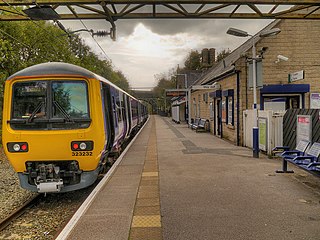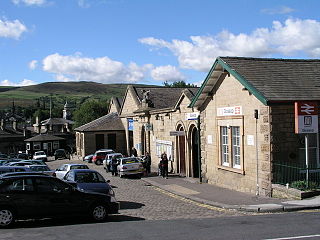The Ashton, Stalybridge and Liverpool Junction Railway was opened in 1846 to connect the industrial town of Ashton-under-Lyne to the developing railway network, and in particular to the port of Liverpool. It was a short line, joining the Manchester and Leeds Railway at Miles Platting and the connection to Liverpool was over that line and the Liverpool and Manchester Railway.

Ashton-under-Lyne railway station serves the town of Ashton-under-Lyne, in Greater Manchester, England. It lies on the Huddersfield Line 6½ miles (10 km) east of Manchester Victoria and is operated by Northern Trains.

Guide Bridge railway station serves Guide Bridge in Audenshaw, Greater Manchester, England, and is operated by Northern Trains. The station is 4+3⁄4 miles (7.6 km) east of Manchester Piccadilly on both the Rose Hill Marple and Glossop Lines.
The Sheffield, Ashton-under-Lyne and Manchester Railway was an early British railway company which opened in stages between 1841 and 1845 between Sheffield and Manchester via Ashton-under-Lyne. The Peak District formed a formidable barrier, and the line's engineer constructed Woodhead Tunnel, over three miles (4.8 km) long. The company amalgamated with the Sheffield and Lincolnshire Junction Railway and Great Grimsby and Sheffield Junction Railway companies, together forming the Manchester, Sheffield and Lincolnshire Railway in 1847.

Wadsley Bridge railway station was a station in Sheffield, South Yorkshire, England on the Great Central Railway's core route between Manchester and Sheffield.

Ashton Park Parade railway station was a station on the line between Guide Bridge and Stalybridge in Greater Manchester, England. This station served the town of Ashton-under-Lyne, now served only by Ashton Charlestown, north of this former station.

Hadfield railway station serves the Peak District town of Hadfield in Derbyshire, England. The station is one of the twin termini at the Derbyshire end of the Manchester-Glossop Line, the other being Glossop. It was opened by the Sheffield, Ashton-under-Lyne and Manchester Railway in 1844.

Glossop railway station serves the Peak District town of Glossop in Derbyshire, England. Glossop is the third busiest railway station in the county of Derbyshire after Derby and Chesterfield.

Wortley railway station was a railway station on the Sheffield, Ashton-under-Lyne and Manchester Railway lying between Deepcar and Penistone. It was built to serve the village of Wortley, in Barnsley, South Yorkshire, England. Wortley Hall, near the village, was the home of the Earl of Wharncliffe, long time associated with railway development in the area.

Dunford Bridge railway station was a railway station that served the village of Dunford Bridge on the Sheffield, Ashton-under-Lyne and Manchester Railway situated immediately east of the Woodhead Tunnel, 5 miles (8 km) west of Penistone, within the Metropolitan Borough of Barnsley, South Yorkshire, England.
The Oldham, Ashton and Guide Bridge Junction Railway (OA&GB) was a British railway company, which opened in 1861, connecting Oldham, Ashton and Guide Bridge. The company survived until it was nationalised in 1948.
Oldham Clegg Street railway station was the Oldham, Ashton-under-Lyne and Guide Bridge Junction Railway station that served the town of Oldham in northwest England, it had three associated goods stations.

Park Bridge Railway Station was a railway station on the Oldham, Ashton-under-Lyne and Guide Bridge Junction Railway (OA&GB) that served the village of Park Bridge, in the Medlock Valley near Ashton-under-Lyne's border with Oldham. It was sometimes known as Parkbridge, and one photograph of the station shows the station name board with the name as one word and immediately adjacent the signal box with it shown as two. The station opened on 26 August 1861 when the line opened.

Park railway station served the Newton Heath and Philips Park areas of Manchester, England.

Ashton Moss Railway Station was a short lived station on the Oldham, Ashton and Guide Bridge Railway (OA&GB) that served the town of Ashton-under-Lyne.
Thurgoland railway station was a small railway station built by the Sheffield, Ashton-Under-Lyne and Manchester Railway to serve the village of Thurgoland, South Yorkshire, England and opened on 5 December 1845. Due to cost-cutting measures involving staff and infrastructure the station was closed, along with Dukinfield Dog Lane, Hazelhead and Oxspring on 1 November 1847, making this one of the shortest-lived stations anywhere, with a life span of just one year and 11 months.
Oxspring railway station was a short lived station built by the Sheffield, Ashton-under-Lyne and Manchester Railway to serve the village of Oxspring, South Yorkshire, England. The station opened on 5 December 1845 but due to cost-cutting measures it was closed, along with Dukinfield Dog Lane, Hazelhead and Thurgoland, on 5 November 1847.
Dukinfield and Ashton railway station served Dukinfield in Greater Manchester, England. The station was built at high level on a viaduct as it passed directly above Alma Bridge, King Street, Dukinfield. Access to the platforms was via an entrance in Cooper Street and ascending a staircase inside one of viaduct pillars. The viaduct extended from Whiteland, Ashton under Lyne, transversed the Tame Valley, passing over Crescent Road, King Street, Wharf Street, Charles Street and the Peak Forrest Canal before plunging under the Old Great Central line at Guide Bride and emerging at Audenshaw. The station was opened on 2 October 1893 by the London and North Western Railway, and was closed on 25 September 1950 by British Railways.

Crowden railway station is a closed railway station on the Woodhead Line between Manchester and Sheffield, that served the hamlet of Crowden, Derbyshire between 1861 and 1957.

Crow Edge is a hamlet in Dunford civil parish, situated on the A616, two miles southeast of Hepworth, West Yorkshire in the metropolitan borough of Barnsley in the metropolitan county of South Yorkshire, England. Until 1974 it formed part of Penistone Rural District.













